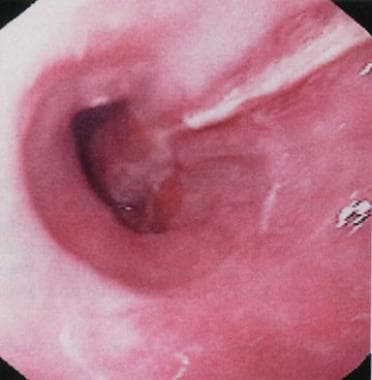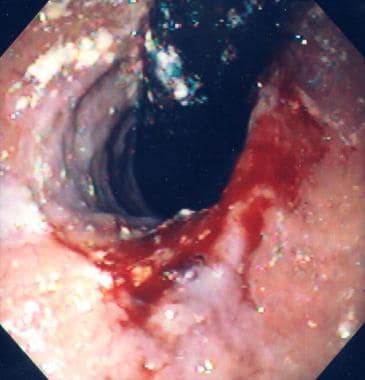Overview of Mallory-Weiss Syndrome
Mallory-Weiss syndrome is characterized by upper gastrointestinal bleeding secondary to longitudinal mucosal lacerations (known as Mallory-Weiss tears) at the gastroesophageal junction or gastric cardia. The original description by Mallory and Weiss in 1929 involved patients with persistent retching and vomiting following an alcoholic binge. [1] However, Mallory-Weiss syndrome may occur after any event that provokes a sudden rise in the intragastric pressure or gastric prolapse into the esophagus, including antecedent transesophageal echocardiography. [2]
Mallory-Weiss tears account for an estimated 1-15% of cases of upper gastrointestinal bleeding. [3, 4] Although the age range varies widely, affected individuals are generally in middle age (40s-50s), and men reportedly have a higher incidence than women by a ratio of 2-4:1.
The images below depict Mallory-Weiss tears.
 Mallory-Weiss tear. Typical longitudinal mucosal tear with overlying fibrinous exudate extending from the distal esophagus to the gastric cardia. Courtesy of C.J. Gostout, MD.
Mallory-Weiss tear. Typical longitudinal mucosal tear with overlying fibrinous exudate extending from the distal esophagus to the gastric cardia. Courtesy of C.J. Gostout, MD.
Risk Factors for Mallory-Weiss Tears
Precipitating factors include retching, vomiting, straining, hiccupping, coughing, primal scream therapy, blunt abdominal trauma, and cardiopulmonary resuscitation. In a few cases, no apparent precipitating factor can be identified. One study reported that 25% of patients had no identifiable risk factor.
The presence of a hiatal hernia is a predisposing factor and is found in 35-100% of patients with Mallory-Weiss tears. [5] During retching or vomiting, the transmural pressure gradient is greater within the hernia than the rest of the stomach, and it is the location most likely to sustain a tear (see
-
Mallory-Weiss tear. Typical longitudinal mucosal tear with overlying fibrinous exudate extending from the distal esophagus to the gastric cardia. Courtesy of C.J. Gostout, MD.
-
Mallory-Weiss tear. Retroflexed view of the cardia showing the typical location of the tear with a clean base.
-
Mallory-Weiss tear with a pigmented protuberance and active oozing.
Tables
What would you like to print?
- Overview of Mallory-Weiss Syndrome
- Risk Factors for Mallory-Weiss Tears
- Potential Mechanisms for Mallory-Weiss Tears
- Evaluation of Mallory-Weiss Tears
- Diagnosis of Mallory-Weiss Tears
- Medical Management
- Endoscopic Management
- Angiotherapy
- Surgical Management
- Outpatient Monitoring
- Complications of Mallory-Weiss Tears
- Outcomes of Mallory-Weiss Tears
- Special Considerations
- Show All
- Media Gallery
- References


